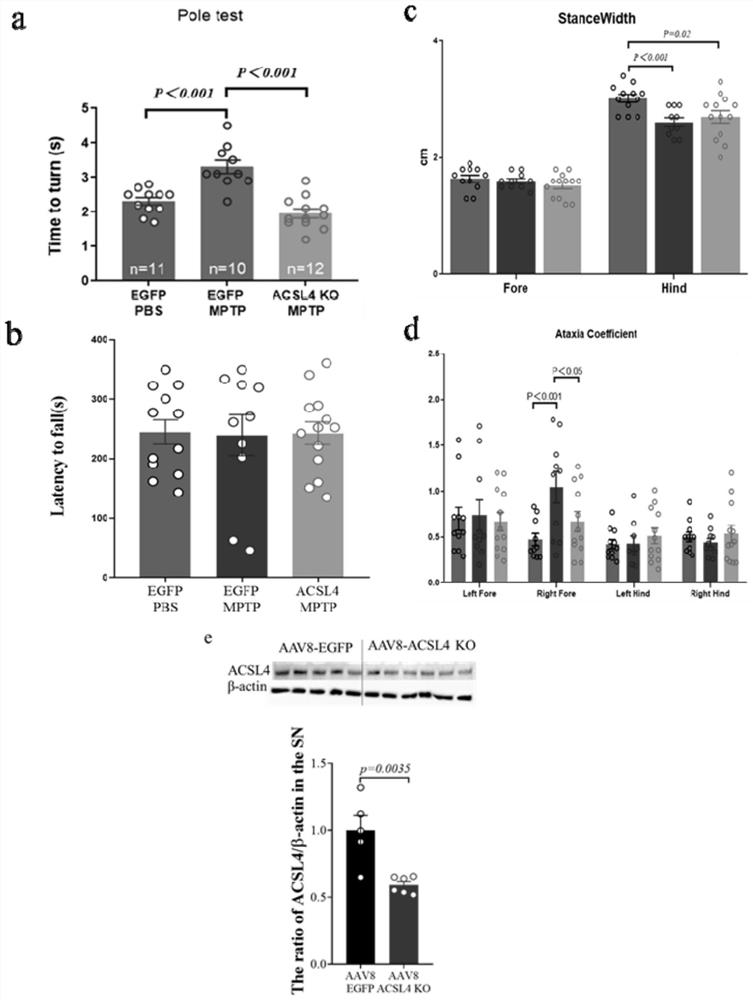Application of inhibitor of acyl-CoA synthetase long chain family member 4 to treatment of Parkinson's disease
A long-chain fatty acyl-coenzyme and synthetase technology, which is used in the treatment of Parkinson's disease, the field of inhibitors of long-chain fatty acyl-CoA synthase 4, and can solve the problem of inability to take care of themselves, decreased quality of life, dysphagia, etc. question
- Summary
- Abstract
- Description
- Claims
- Application Information
AI Technical Summary
Problems solved by technology
Method used
Image
Examples
Embodiment 1
[0059] Based on the published human database GSE20141 data, the transcriptome data of long-chain acyl-CoA synthetase 4 was statistically analyzed, and the long-chain acyl-CoA synthetase 4 gene (ENSG00000068366) was found in SNpc of patients with Parkinson's disease Increased expression ( figure 1 In a), gene expression also increased in serum ( figure 1 Middle b, c).
Embodiment 2
[0061] 1-Methyl-4-phenyl-1,2,3,6-tetrahydropyridine (MPTP) can be dehydrogenated to MPP in substantia nigra cells + Ions, which inhibit the mitochondrial complex enzymes and cause the cell to die. MPTP is one of the commonly used drugs to make animal models of Parkinson's disease.
[0062] C57 mice were intraperitoneally injected with MPTP (20 mg / kg), four times in eight hours, once every two hours. Behavioral tests were carried out from day 19 to day 21 after injection. The pole-climbing test showed that MPTP-injected mice turned their heads significantly longer, and the open-field test showed that the movement speed of MPTP-injected mice was significantly slower, indicating that the mice's motor ability was impaired ( figure 2 Middle b, c): On the 21st day, the mice were euthanized, and after perfusion with PBS, the expression of Tyrosine hydroxylase (Tyrosinehydroxylase) and ACSL4 was detected in the substantia nigra of the left brain, and the right brain was soaked in 4...
Embodiment 3
[0064] The in vivo application of AAV virus vectors in the nervous system has the advantages of safety, high efficiency and low toxicity, and is very suitable for the research of the nervous system. Knockdown of ACSL4 expression in the substantia nigra was achieved by injecting the AAV8-ACSL4 virus vector capable of knocking out the mouse ACSL4 gene in the substantia nigra of mice ( image 3 Middle e), 30 days after virus injection, the MPTP model of Parkinson's disease was constructed, and the protective effect of substantia nigra ACSL4 knockout on the Parkinson's disease model was evaluated by behavioral detection and pathological section detection. The results showed that AAV8-mediated ACSL4 gene knockout could alleviate the motor impairment in Parkinson's disease model mice ( image 3 Middle a-d) and the reduction of expression of tyrosine hydroxylase after rescue MPTP modeling ( Figure 4 Middle a, b) and reduce the death of dopamine neurons ( Figure 4 Middle c, d).
PUM
 Login to View More
Login to View More Abstract
Description
Claims
Application Information
 Login to View More
Login to View More - R&D
- Intellectual Property
- Life Sciences
- Materials
- Tech Scout
- Unparalleled Data Quality
- Higher Quality Content
- 60% Fewer Hallucinations
Browse by: Latest US Patents, China's latest patents, Technical Efficacy Thesaurus, Application Domain, Technology Topic, Popular Technical Reports.
© 2025 PatSnap. All rights reserved.Legal|Privacy policy|Modern Slavery Act Transparency Statement|Sitemap|About US| Contact US: help@patsnap.com



